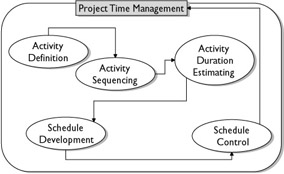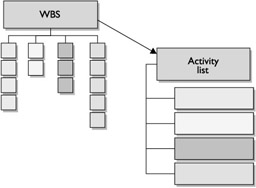Defining the Project Activities
|
| < Day Day Up > |
|
Projects are temporary undertakings to create a unique product or service. The idea of time is inherent to the very definition of a project in that all projects are temporary. Projects may seem to last forever, but sooner or later they must end. Adequate planning of the temporary project can predict when a project will end. Within this short, limited time, the project manager must create something: a product or a service. The creation is about change-and change, as you may have guessed, takes time. Figure 6-1 shows the components of project time management.

Figure 6-1: Time management relies on several inputs to help build and control the schedule.
Creation of the product or service comes about due to the work the project team completes. The sum of the time of the work equates to when the project is completed. In addition to the duration of activities, there are other factors of time to consider:
-
Project management activities
-
Planning processes
-
The sequence of activities
-
Procurement
-
Reliance on internal and external events
-
Known and unknown events affecting the project
Project time management is based predominantly on planning, and then it's all control and execution. Planning for project schedules may stem from deadlines, customer demands, hard and soft logic, and a bit of prediction.
Considering the Inputs to Activity Definition
The activity list is an output of activity definition, and includes all of the activities to be performed within the project. The list must be in alignment with the project scope. Remember the project scope? It's a description of all the required work, and only the required work, to complete the project. In a sense, the activity list is a further definition of the project scope since it includes only those actions needed to complete the project scope.
Creating the activity list relies on several completed documents, knowledge, and actions. The creation of the activity list uses the following as inputs to the process:
-
WBS The WBS serves as a major input in the creation of the activity list. Recall from Chapter 5 that the WBS is a deliverables-orientated collection of project components. It is not a collection of activities to create the deliverables.
-
Scope statement It is a description of the required work, and only the required work, to complete the project.
-
Historical information If the project's been done before, what activities were included in the similar project? Historical information is proven information that the project manager can rely on for creating activity lists.
-
Constraints What restrictions are imposed on the project manager and the project team? For example, is there a deadline for the project? A predetermined budget? Demanded quality metrics? These are examples of constraints.
-
Assumptions What assumptions have been identified for the project work? For example, consider the availability of resources, acceptable weather, and time allotments to complete the project.
-
Expert judgment Expert judgment allows experts to influence decisions in regard to the needed work packages.
Decomposing the Project Work Packages
The WBS, the collection of deliverable-orientated components, must now be broken into activities. Specifically the work packages within the WBS must be decomposed into manageable work elements. What's the difference between decomposing the project deliverables and the project work? The elements in the WBS are deliverables; this process is concerned with the actions needed to create the deliverables.
It's quite possible to create the WBS and the activity list in tandem. Don't get too caught up in the timing of the activity list definition and the WBS. Simply put, the WBS describes the components of the deliverables; the activity list defines the actions to create the deliverables.
Exam Watch
The creation of the WBS and the activity list is not a solo activity. The WBS and the activity list are created with the project team.
Relying on Templates
Why reinvent the wheel? If similar projects have been completed in the past, rely on the WBS and activity lists from this historical information to serve as a template for the current project. Even if a portion of a project is similar, a project manager can use the activity list and focus on the similarities of the current project.
A template can include several elements to make a project manager's life easier and the new project more successful:
-
Required actions to complete the project scope
-
Required resources and skills
-
Required hours of duration for activities
-
Known risks
-
Outputs of the work
-
Descriptions of the work packages
-
Supporting details
Compiling the Activity List
Ta-dah! The primary output of decomposing the work is the activity list. The activity list is a collection of all of the work elements required to complete the project. The activity list is actually an extension of the WBS, and will serve as a fundamental tool in creating the project schedule. The activity list is needed to ensure that all of the deliverables of the WBS are accounted for and that the necessary work is mapped to each of the deliverables as shown in Figure 6-2.

Figure 6-2: Activity lists are organized as extensions of the WBS.
The activity list also ensures that there is no extra work included in the project. Extra work costs time and money-and defeats the project scope. The correlation between the WBS and the work package is a one-to-one ratio: the deliverables in the WBS map to the required work. In other words, the WBS is comprised of all of the components the project will create. The activities list is comprised of all of the work required to create the components within the WBS.
In addition, the work on the activity list includes descriptions of each identified activity. This accomplishes three things:
-
Ensures the team members are in agreement on what the work package accomplishes
-
Ensures the work supports and creates the WBS deliverables
-
Ensures the work is within the project scope
Organizing the Supporting Detail
The supporting detail of the activity list must be documented, organized for fast reference, and accessible throughout the project implementation. The supporting detail allows the project manager, the project team, and other interested parties to reference the activity list definition process and recall why decisions were made and how the activity list was created. The supporting detail includes:
-
Assumptions
-
Constraints
-
Reasoning behind identified work package
-
Information specific to the industry that the project is operating within
Updating the Work Breakdown Structure
When creating the activity list, the project team and the project manager may discover discrepancies or inadequacies in the existing WBS. Updates to the WBS allow the project manager to ensure that all of the needed project deliverables are included in the WBS and then map the discovered deliverables to the identified work in the activity list.
In addition, the elements within the WBS may not be defined fully or correctly. During the decomposition of the work, elements of the WBS may need to be updated to reflect the proper description of the WBS elements. The description of the WBS should be complete and full-and leave no room for ambiguity or misinterpretation. Finally, updates to the WBS may also include cost estimates to the discovered deliverables.
Exam Watch
Updates to the WBS are called refinements. As the project moves towards completion, refinements ensure all of the deliverables are accounted for within the WBS. Refinements may also call for, indirectly, updates to the activity list.
|
| < Day Day Up > |
|
EAN: 2147483647
Pages: 209